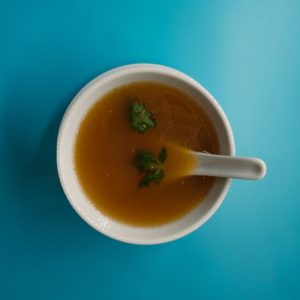What Is Hondashi?
Hondashi is a Japanese staple soup stock powder. It comes in small granules that are easy to measure and quickly adds seasoning to many native Japanese dishes. Because of its authentic Japanese taste, Hondashi should be in anyone’s pantry who plans on getting a genuine Japanese flavor in their dishes.
There are a few dashi powder products and Hondashi is a common product of Ajinomoto. The soup stock doesn’t come in only one flavor either, below are some of the other types of Hondashi flavors.
- Kombu (kelp)
- Bonito
- Kombu and Bonito Mix
- Iriko
- Flying fish
- Rich (a combination of bonito, flying fish, mackerel, kombu, and shiitake)
Despite being made from fish, Hondashi has a surprising lack of fish taste. The spice has a salty and sweet taste with a light smoky undertone.
Hondashi Ingredients
Hondashi ingredients are simple but not too familiar if you’re not accustomed to Japanese food. Hondashi contains salt, monosodium glutamate, lactose, sugar, dried bonito powder, disodium inosinate, bonito extract, yeast extract, disodium succinate.
Those ingredients are for the Ajinomoto Hondashi and won’t be the exact same for any homemade variants.

How To Use Hondashi
Hondashi can be used by itself as a soup stock, but is commonly used in combination with other spices. Some common combinations with Hondashi are soy sauce and miso paste.
Using the spice is fairly simple, it comes in small pellets that dissolve in water. Usually, they’ll be added to a broth for flavor like its use in Miso Soup. Soups aren’t the only dish to use Hondashi in. Hondashi is a popular spice that can go into just about any Japanese dish including most noodle recipes.
5 Hondashi Substitutes & Alternatives
Maybe you want to make some Miso Soup or another signature Japanese dish that uses Hondashi? But what do you do when you don’t have any and the stores near you don’t carry it?
Thankfully, there are a few substitutes for Hondashi if you can’t find any near you!
Shiro-Dashi
Similar to Hondashi, Shiro-Dashi is a concentrated soup base. There are two key ingredients that make up Shir-Dashi, the dashi extract and soy sauce. The dashi extract can be derived from a few sources such as bonito, seaweed, shiitake mushrooms, iriko, and more.
Because of it’s base ingredients, Shiro-Dashi will have a similar umami taste to that of Hondashi, making it a Hondashi substitute.
Mentsuyu
Another great Hondashi substitute is Mentsuyu. This is a basic soup or broth that gets it’s flavor from the same ingredients that make dashi powders, kombu and bonito flakes. Because of it’s similar ingredients and taste, it makes for a great alternative to a dashi powder.
Kombu-Tsuyu
Similar to Mentsuyu, Kombu-Tsuyu is a concentrated soup stock that has a passing resemblance in taste. This soup stock is also derived from kombu and bonito, making it just as good of a replacement as Mentsuyu.
Dried Bonito Shavings
If other Hondashi stock substitutes can’t be found, then settling for one of the main ingredients in the stock will do. You can buy dried bonito shavings as a stock alternative while maintaining a genuine Japanese taste.
Chicken Stock Powder
Chicken stock powder or chicken bouillon powder is something to use in a pinch. This will lack some of the traditional taste as it’s chicken powder and not kombu/bonito, but it will still make do if there’s nothing else around.
Is Hondashi Gluten Free?
The Ajinomoto Hondashi does not contain any gluten ingredients, therefore it’s gluten free! However, like most mass-produced foods, there is a risk of cross contamination.
So, even though Hondashi isn’t made with ingredients that have gluten, there may be other foods and spices made in the same place that use gluten products. I recommend caution when using any ingredient that may be cross contaminated.
Does Hondashi Have MSG?
The Ajinomoto Hondash does contain monosodium glutamate (MSG) that has been extracted from natural sources such as kelp and bonito flakes.
There’s plenty of debate on the health benefits/risks of MSG and whether or not it’s safe to eat. I love the added flavors from MSG but try to limit how much I eat.
Does Hondashi Need To Be Refrigerated?
Hondashi is a dried pellet soup stock base and is already in its best form for storage. But how do you store Hondashi?
Hondashi can be refrigerated and will help preserve it, but the most important aspect is to keep it airtight after use. This means you can also store it in a cool dark place as long as it’s sealed. Nothing lasts forever and the same goes for this soup stock. So be careful before using it again and make sure it doesn’t have an altered smell.
If you’re questioning whether your Hondashi is expired or not, it would be best to not risk it and get another pack.




Comments are closed.